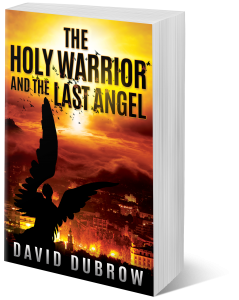The Armageddon Series: The Rest of the Story
 I started writing the Armageddon trilogy in early 2013, with the outline of The Blessed Man and the Witch. My intent was to follow the original Star Wars trilogy style: set up the overarching concern in the first volume (in this case, the end of the world), have the main characters try and fail to overcome this concern in the second volume (The Nephilim and the False Prophet), and then complete the story of good versus evil in the third volume, The Holy Warrior and the Last Angel. So it’s taken me close to six years to write and publish all three books.
I started writing the Armageddon trilogy in early 2013, with the outline of The Blessed Man and the Witch. My intent was to follow the original Star Wars trilogy style: set up the overarching concern in the first volume (in this case, the end of the world), have the main characters try and fail to overcome this concern in the second volume (The Nephilim and the False Prophet), and then complete the story of good versus evil in the third volume, The Holy Warrior and the Last Angel. So it’s taken me close to six years to write and publish all three books.
Overall, I saw my intent through in the writing. Each book in the trilogy comprises a segment of the overall story of the end of the world. Each character had an individual character arc in not just each book, but through the entire trilogy. When characters like Hector and Siobhan and Ozzie and Kyle weren’t driving events themselves, they were affected by other events, which then altered how they acted in response to future events. Some characters underwent significant transformation both physically and spiritually, like Reyna and Siobhan. Others stayed more consistent…and suffered for it. I wanted to make them as much like real people as possible without robbing the reader of entertainment. If you make everything too realistic, with the real world’s lack of closure and unspoken secrets and unfulfilled ambitions, nobody’ll want to read it. So everything gets wrapped up in the story.
My success in all these things needs to be judged by the reader. Of course I’m going to say I did a good job.
I had two themes that I wanted to bring out in the third book to keep it from becoming a tedious recitation of descriptive horror at the end of the world; these themes guide my faith, so I think they’re important. The first theme is that God is all good all the time. There’s an objective good in the novel, represented by God and His angels, and there’s an objective evil, represented by the Devil and his demons. The second theme builds on the first: even if we don’t know what God has planned for us, we should trust that He is all good all the time, and knows what’s best for us. In other words, I wanted to make the issue of faith a driving force in the story without preaching. So many of the characters (who were areligious or, at the very least, pretty secular before the first page of the first book) come to faith through pragmatism. They learn from their experiences. It’s what mature adults do.
Except for the ones who don’t. And we see what happens to them.
Robert Thorn, Damien’s father in The Omen, wasn’t a religious man until evidence showed him that his son was the Antichrist. Chris MacNeil didn’t believe in the Devil until her daughter was possessed by a demon in The Exorcist. You get it.
Despite all my planning, there were certain story elements, particularly the Watchers’ plan to save humanity, that I hadn’t fully realized until writing the second and third books. I knew it was all going somewhere, but I wasn’t sure where until the end. Dunno how I came up with the Watcher’s Ark. Or what it would look like inside. I can say that Naram-Sin’s Nephilim body came to me in a dream.
But somehow I got there. I got to the end. While I was stalled on certain story elements I wrote or contributed to other books, like the Appalling Stories series. But I always knew I’d finish this story, as difficult as it was. Hopefully it’s satisfying.
What’s next? Something more science fiction-oriented. Less heavy. Smaller stakes. Not as dark. But I think you’ll enjoy it. I’m done with horror for the time being. I’ve written the horror story I always wanted to write. That’s not so bad.










